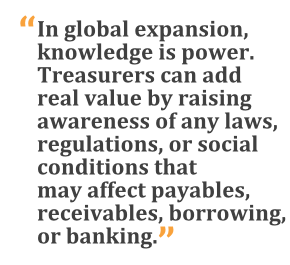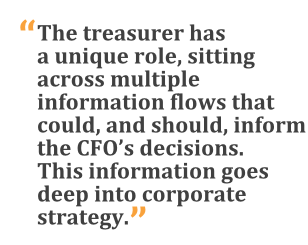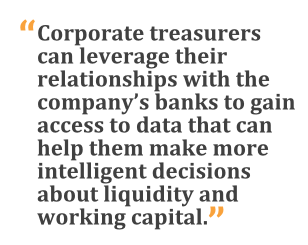 When the external environment is roiling, the key to successfully navigating the tumult is to not just accept, but in fact leverage, the forces of change. That often holds true for professionals in any career path, but it's certainly the case for treasury professionals today.
When the external environment is roiling, the key to successfully navigating the tumult is to not just accept, but in fact leverage, the forces of change. That often holds true for professionals in any career path, but it's certainly the case for treasury professionals today.
Since last decade's liquidity crisis, the role of the corporate treasurer has been wholly transformed. In this era of heightened counterparty risk, low interest rates, and tight liquidity and credit, effective management of the treasury function has become a determining factor in businesses' success. As a result, the role of corporate treasurer has become both more visible and more strategic than ever before.
These days, CFOs and boards of directors are increasingly relying on the treasurer's insights to help them make the right decisions at the right time. From ensuring that global capital levels are adequate to support growth and minimize liquidity risk, to engaging in corporate initiatives that require proficiency with increasingly complex accounting, tax, legal, and regulatory rules, the treasurer's insights have been in high demand over the past decade. Likewise, the value of a strategic treasurer has become more pronounced. Effective treasurers today are measured on their ability to manage initiatives beyond the traditional role. And their ability to successfully support the varied needs of their company may well define the strategic direction of the organization.
Of course, treasurers must continue to ensure that their company's payments mechanisms are effective, that its cash flow forecasting and management are appropriate, and that relationships with its banks remain productive. At the same time, they must navigate new regulations and technologies, which are having a profound impact on the day-to-day operations of their function, as well as on the banks that support them. And they need to be prepared to advise senior management on the cash-flow implications of expanding into new markets around the world. Managing it all is a challenge—but within the challenge lie unmistakable opportunities.
The Regulatory Opportunity
People usually don't think of government regulations as a source of great opportunity, but viewing regulations as only a burden is shortsighted. The recent onslaught of regulations, in its abundance, has changed the ways in which both banks and treasury functions operate. And the changes continue to come. In fact, a new regulation is published every 22 days, according to a 2013 report from the Financial Times. Keeping up with these changes often presents challenges, yet smart treasurers are embracing the opportunities.
For example, the Single Euro Payments Area (SEPA) presents substantial opportunities for any company that accepts payments or performs cash management functions within the Eurozone. Most organizations will have to alter their accounts receivable (A/R) technology infrastructure in order to comply with SEPA. Treasurers who embrace the potential for improvements that is inherent in this change are revamping processes and automating receivables activities. Some are looking at SEPA as a good reason to standardize and centralize payment processes, not only in the Eurozone but around the world. By going above and beyond the letter of the law, leading treasuries are finding opportunities to lower their company's operating costs, increase integration among their software systems, and achieve big benefits through economies of scale.
Geographic Economic Power Shift
 On top of the legal and regulatory issues that directly affect their function, treasurers need to stay abreast of the continuously evolving global economic environment. Economic power is clearly shifting to the south and to the east. HSBC expects growth rates of around 1.7 percent for the developed world, compared with about 4.9 percent for the emerging world, driven by Asia and Latin America. And while the rise of trade in the southern hemisphere may not appear to be a boon for Western companies, there are opportunities for developed-world businesses to plug into this growth if they know where they can add value in today's increasingly disaggregated supply chains.
On top of the legal and regulatory issues that directly affect their function, treasurers need to stay abreast of the continuously evolving global economic environment. Economic power is clearly shifting to the south and to the east. HSBC expects growth rates of around 1.7 percent for the developed world, compared with about 4.9 percent for the emerging world, driven by Asia and Latin America. And while the rise of trade in the southern hemisphere may not appear to be a boon for Western companies, there are opportunities for developed-world businesses to plug into this growth if they know where they can add value in today's increasingly disaggregated supply chains.
Emerging markets are increasingly consumers and investors as well as producers. Latin America is already a net importer of manufactured goods. The astonishing fact is that globally another 3 billion people are expected to join the middle class in the next 40 years, most of them in the emerging world. In 2012, emerging economies generated almost one-third of global foreign direct investment outflows, according to the United Nations Conference on Trade and Development (UNCTAD). It is important to note that although China is a major force in emerging-market growth trends, it is not alone. In fact, we have already seen some manufacturers that operate in China shifting toward more sophisticated, less labor-intensive processes as land and wage costs rise there.
These global geographic and demographic shifts are impacting companies' working capital positions, their payables and receivables, their liquidity position, and their trade finance requirements. Due to the interconnectivity of the global economy, coupled with the inherent shift in economic growth, few treasury functions are isolated from these changes, regardless of their organization's current mix of international and domestic business. Ultimately, we are all affected by the evolution of the macroeconomic global environment, and we will continue to be affected in the coming years. As corporations expand sales channels or supplier networks around the world, the challenge for treasurers will be extending the financial supply chain so that it always provides optimal support for the organization's physical supply chain. In many cases, moving into new markets raises clearing-infrastructure or regulatory issues that the company may not have dealt with previously, issues that may well impact other areas, such as liquidity management.
 In global expansion, knowledge is power. Companies entering a new market need a clear picture of all the ways in which that market's unique characteristics might impact their cash flow. Thus, treasurers can add real value when their organization is venturing into the unknown by raising awareness of any laws, regulations, or social conditions that may affect payables, receivables, borrowing, or banking activities in the region. A company's expansion plans, including the introduction of new products, is not going to get off the ground easily if the treasury team doesn't manage currency and foreign exchange issues properly, or if they've overlooked a necessary component of the infrastructure for making or receiving payments.
In global expansion, knowledge is power. Companies entering a new market need a clear picture of all the ways in which that market's unique characteristics might impact their cash flow. Thus, treasurers can add real value when their organization is venturing into the unknown by raising awareness of any laws, regulations, or social conditions that may affect payables, receivables, borrowing, or banking activities in the region. A company's expansion plans, including the introduction of new products, is not going to get off the ground easily if the treasury team doesn't manage currency and foreign exchange issues properly, or if they've overlooked a necessary component of the infrastructure for making or receiving payments.
Identifying, disseminating, and communicating this information requires a treasurer to leverage multiple information streams, including legal counsel, tax experts, consultants, client-facing resources, and banks. At the same time, the treasurer must cultivate an internal network for influencing and driving change within the company. The ability to consolidate knowledge from disparate sources and effectively convey it to corporate management is of paramount importance for global treasurers, especially when they're entering new markets. Employing a communal approach to discussions about entering new markets—including steering committee and working group members from each discipline—helps a treasurer, and his or her company, better understand all the relevant decisions. It's a challenge, to be sure. But like regulatory changes in familiar markets, it's also an opportunity for treasurers to prove their strategic worth.
Technology Rules the Day
Technology has utterly revolutionized consumer banking over the past 10 years. Now it's doing the same for commercial banking. Corporate banking customers are gaining greater visibility into their money and greater power to direct it where (and when) they see fit. For example, advanced rule-based end-of-day sweeping allows for a passive, scenario-based concentration of excess liquidity. Layered in on top of this are advanced rule-based investment engines that automate the management of excess liquidity positions to any number of investment end points.
Additionally, the regional and global enterprise resource planning (ERP) tools that are now commonplace at many organizations enable treasurers to develop meaningful, objective, and strategic recommendations rapidly using real-time global information. As globalization continues to mature, so will the concepts of virtual and mobile treasury. Not only can new technologies simplify a treasurer's day-to-day operations, but they can also provide valuable insights.
The treasurer has a unique role, sitting across multiple information flows that could, and should, inform the CFO's decisions. This information goes much deeper into corporate strategy than just cash positions. Internally, treasurers must effectively digest information and incorporate input from financial planning, business development, and sales and marketing to ensure that objectives are clear and that the necessary resources are made available. Externally, feedback from shareholders, ratings agencies, banks, and other credit providers should help shape the appropriate capital structure and deployment strategies. Treasurers who succeed in using technology to collect, marshal, and deploy information by orchestrating meaningful and comprehensive discussions can add significant value to their organization and thereby help solidify their strategic position within the company.
 Furthermore, corporate treasurers can leverage their relationships with the company's banks to gain access to data that can help them make better-quality, more intelligent decisions about liquidity management and the company's working capital. Banks are effectively the ambassadors of best practices in liquidity and working capital management across various industries and geographies. The strategic treasurer leverages the knowledge of his or her partner banks to understand the drivers of successes and failures in other organizations. In the future, clients will lean on banks more than ever before, and the ability of a bank to deliver valuable information will ultimately dictate the success of these relationships.
Furthermore, corporate treasurers can leverage their relationships with the company's banks to gain access to data that can help them make better-quality, more intelligent decisions about liquidity management and the company's working capital. Banks are effectively the ambassadors of best practices in liquidity and working capital management across various industries and geographies. The strategic treasurer leverages the knowledge of his or her partner banks to understand the drivers of successes and failures in other organizations. In the future, clients will lean on banks more than ever before, and the ability of a bank to deliver valuable information will ultimately dictate the success of these relationships.
In fact, HSBC has found that our conversations with our customers have changed. When considering expansion into a new market, clients now seek our help and guidance in how to structure their operations for success rather than help in just making payments. Aided by new technology and greater insights, banks are able to provide advisory services, as well as implement new technology. It's a rapidly-evolving model of “value added.” These changes open up the possibility of new collaboration between companies and across all banking partners in a way that has not been possible before.
Embracing the Trends
At the intersection of technology advancements, evolving regulatory regimes, and global economic shifts sits the corporate treasury function. To meet expectations in this environment, a treasurer must bring valuable new insights to the conference room table.
Many businesses are finding that the best way to winnow out these insights is to standardize and centralize the global treasury organization. Smart treasurers help their company compare the benefits and tradeoffs of different organizational structures, weighing customization and independence of action against companywide strategic partnerships, collaboration, and shared services.
According to a 2013 CapGemini payments report, several key industry initiatives under way now are specifically focused on payments, including SEPA migration. While their individual objectives may differ, they are all primarily aimed at standardizing processes for greater transparency and enhanced risk management.
At the same time, many markets that have traditionally been restricted are opening up, making it more feasible to run a truly global treasury function. For example, China is working toward internationalization of the renminbi (RMB), which will make it easier for companies to conduct cross-border business inside and outside of mainland China.
Clearly, there is no simple recipe for success in this day and age. Standardizing treasury is a good option for many companies, but it's not right for every business. Ultimately, modern treasurers need to analyze the intelligence needs of their organization as it works to manage the risks and seize the opportunities that the future brings. Then they need to determine how they can generate valuable insights that support those decisions. At the top of the list for most treasurers will be understanding the macroeconomic changes in the world, analyzing the treasury impacts of globalization and the economies of scale that accompany it, grasping the ramifications on cash flow of the unrelenting march of technology, and positioning the treasury function for the increasingly important role companies are expecting it to fill. Those treasurers who embrace these trends—and, of course, their related insights—will be those best positioned to thrive in the long-term.
———————————————-
 Diane S. Reyes is global head of payments and cash management for HSBC Holdings plc, managing P&L ownership, product, client, risk, and operations management as well as sales and distribution across the globe.
Diane S. Reyes is global head of payments and cash management for HSBC Holdings plc, managing P&L ownership, product, client, risk, and operations management as well as sales and distribution across the globe.
 Michael Cummins is executive vice president and North America head of payments and cash management for HSBC, overseeing all sales, client, business, risk, and control management of the function as well as product strategy and innovation in the region.
Michael Cummins is executive vice president and North America head of payments and cash management for HSBC, overseeing all sales, client, business, risk, and control management of the function as well as product strategy and innovation in the region.
© 2025 ALM Global, LLC, All Rights Reserved. Request academic re-use from www.copyright.com. All other uses, submit a request to [email protected]. For more information visit Asset & Logo Licensing.




